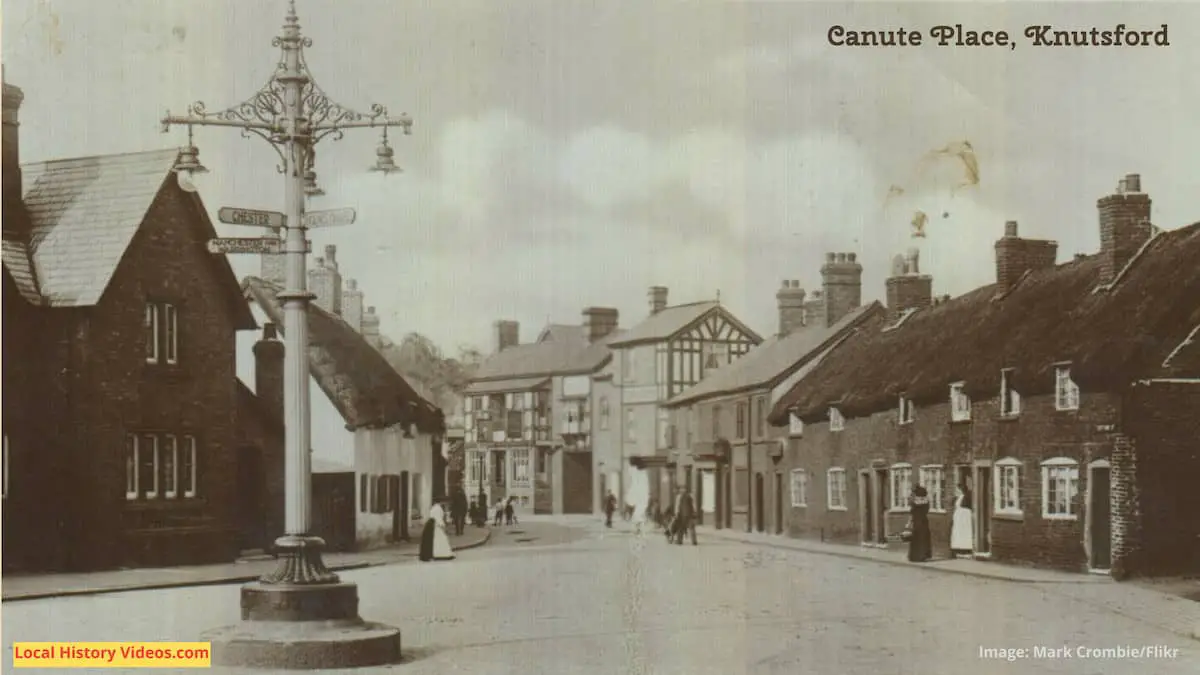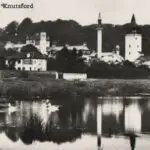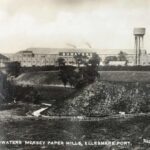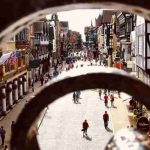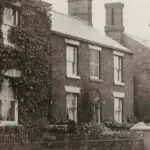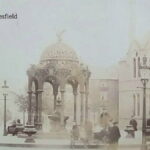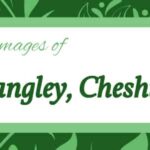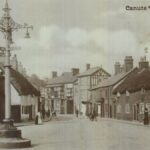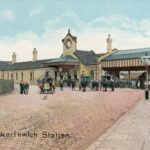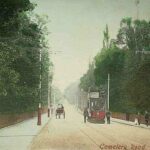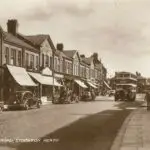Glimpse history through old images of Knutsford, Cheshire, England.
The pretty market town of Knutsford in Cheshire has, not surprisingly, caught the attention of filmmakers even back in the early 20th Century.
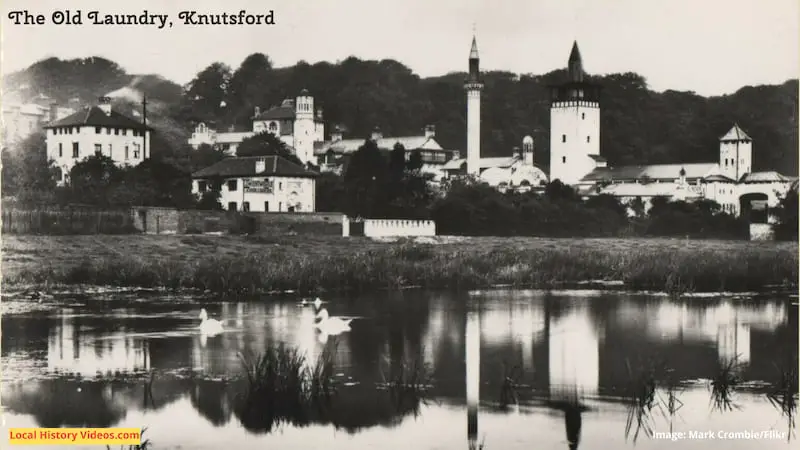
May Day Queen
Every year Knutsford’s May Day celebrations include crowning the May Queen. In the 1920s, silent newsreels captured the large street procession and the May Queen ceremony.
It’s surprising just how many costumed people are taking part.
Crowning The May Queen (1922) – British Pathé on YouTube
Crowning The May Queen (1926) – British Pathé on YouTube
Crowning The May Queen (1928): British Pathé on YouTube
QUIRKY: Election and crowning of May Queens (1928) – British Pathé on YouTube
1940s Knutsford
In the 1940s, British Pathé filmed the quiet streets of Knutsford, where pedestrians outnumbered the passing cars. Even back then the local historic buildings were appreciated for their quirkiness and beauty.
The first clip lasts just under a minute. We are told the market town is “one of the dormitories of Manchester”.
Knutsford Issue Title Is You Never Know You Know (1943): British Pathé (YouTube)
In this next short, half-minute clip, a poor young man trips as he comes into the camera frame.
Knutsford Village (1940-1949): British Pathé (YouTube)
A Bit of Knutsford History
Extracts from “Knutsford, Its Traditions and History With Reminiscences, Anecdotes, and Notices of the Neighbourhood”, by Henry Green
Published in 1859
Pages 16 – 18
All who conduct that survey, soon learn what Knutsford now is ; and I will only very briefly name the principal buildings, with the dates of their erection. The new church of St. Cross dates from the year, 1857 ; that of Toft from 1855 ; the Savings Bank, 1840 ; the Union Poor House, 1837 ; the Parochial School, from 1830 ; the County House of Correction, from 1818 ; the late Mrs. Egerton’s School for Girls, from about 1815 ; the Independent Chapel, from 1803 ; and the Wesleyan Chapel, from 1796 : the Parish Church and the rebuilding of the Grammar School, from 1744 ; and my own old Chapel, styled at its erection the “New Meeting House,” from 1688.
At the beginning of this century, nearly sixty years ago, in the year 1801, the site of the County Gaol was a field ; there was in the Silk – mill – street, a large silk factory, erected in 1770 ; at Watson’s corner, on the way to the race – course, stood the Sessions ‘ House ; near Tatton Park, at the entrance almost, were a factory and many cottages ; the Angel Inn was on the opposite side of the street ; where the parochial School has been erected, were ten or twelve cottages ; Paradise Green was, as the race – course now is, an Eden for tame aquatic fowls, and Adam’s Hill was a wild dell, with picturesque banks, instead of being confined by two parallel stone walls and hedges.
Go back sixty years more, to 1740 ; where Grove House now stands, there was merely a tithe barn ; in the town no parish church existed ; Tabley House and the present Norbury Booths had not been erected ; the Hall at Tatton was a much humbler structure than the one which now commands so distant a prospect, the park itself was smaller, and within the present boundaries were contained several farms, the hedge row timber of which still remains, and two Meres instead of one.
Several of the houses in Knutsford take their origin from the beginning of the eighteenth century, about A.D. 1700 or 1705. The house used now as the”Rose and Crown, “bears the date 1649, the year in which Charles the First was tried and beheaded.
For any other building in the town we cannot with absolute confidence go further back than this date, though the house in which Mr. John Ardern lives, and of which one of the bed – rooms bears evident marks of antiquity, was probably built fully three hundred years since, while Calais was an English fortress, and when Cranmer, Ridley, and Latimer suffered at the stake.
At the turn of the road from Brook House to the Cross Town, there is a cottage, the fate of which resembles that of the Highlander’s musket, new stock, new lock, and new barrel, all new except the ramrod ; on the timbers of this cottage is the date 1411, -four hundred and forty – seven years ago. This date refers us almost to the period 1403, when Percy Hotspur at the Battle of Shrewsbury was slain, and many a Cheshire knight and squire fell fighting on his side ; to the time when Henry V. invaded France ; before Joan of Arc had been burned in the Market – place of Rouen, 1431 ; before the Wars of the Roses had desolated England ; before printing had been invented, and almost a century before America had been discovered. Indeed, the date 1411 takes us back nearly to the time, 1382, when Wickliffe made the first translation of the Holy Scriptures into the English language ; and within forty years of the birth of a truly English literature, in the writings of Gower and Chaucer.
But we must own that this date on the old beam, 1411, is of questionable authority, if it be true, as some tell us, that our present Arabic numerals, those which we use in Arithmetic, were not introduced into England previously to the year 1522. There is no good instance, it is said, of any general use of the Arabic numerals before the invention of printing; even the works of Caxton, our earliest English printer, do not contain them, except in a wood – cut ; and up to the sixteenth
century merchants kept their accounts in the Roman numeral letters. For these reasons we are asked to conclude that the date in Arabic numerals, 1411, of which we have been speaking, is not to be trusted to with certainty as the real date on any house in England …
Page 18
We must now take a great leap to arrive at the next work of human art connected with Knutsford. The leap is across 1800 years, to the time when the Romans held possession of Britain.
We have in this immediate neighbourhood the names, Holford – street, Tabley – street, and High – street ; they are portions of the road from the Bollin past Bucklow Hill, and on to Northwich, and in their origin belonged to the old Roman road, which in some places coincided with the older road of the Britons.
The word street, we may observe, was introduced by the Romans themselves. It is one of the few words of Latin origin handed down from the days of the Roman occupation of Britain, and denoted, not as it does now, two rows of houses, one on each side of the public road, but simply any road regularly made and carefully kept up.
More about Cheshire
- Old Images of Cheshire, England
- Old Images of Ellesmere Port
- Old Images of Chester Zoo
- Old images of Winsford, Cheshire
- Old images of Widnes, Cheshire
- Old Images of Warrington, Cheshire
- Old Images of Sandbach, Cheshire
- Old images of Runcorn, Cheshire
- Old Images of Macclesfield, Cheshire
- Old images of Langley, Cheshire
- Old images of Trentabank Reservoir, Macclesfield Forest
- Old Images of Crewe, Cheshire
- Old Images of Knutsford, Cheshire
- Old Images of Northwich, Cheshire
- Old images of Congleton, Cheshire
- Old Images of Bollington, Cheshire
- Old Images of Harold Wilson, British Prime Minister
- Nantwich: Old Photos & Film
- Chester, Cheshire: History in Old Images
- Cheshire: Local History Resources

